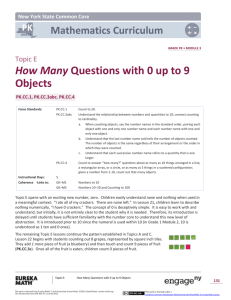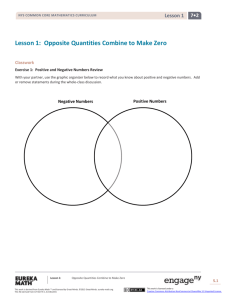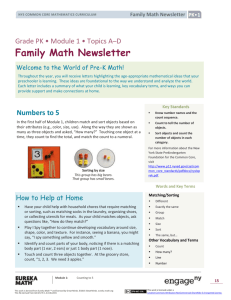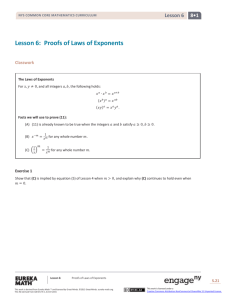grade pk • module 1
advertisement
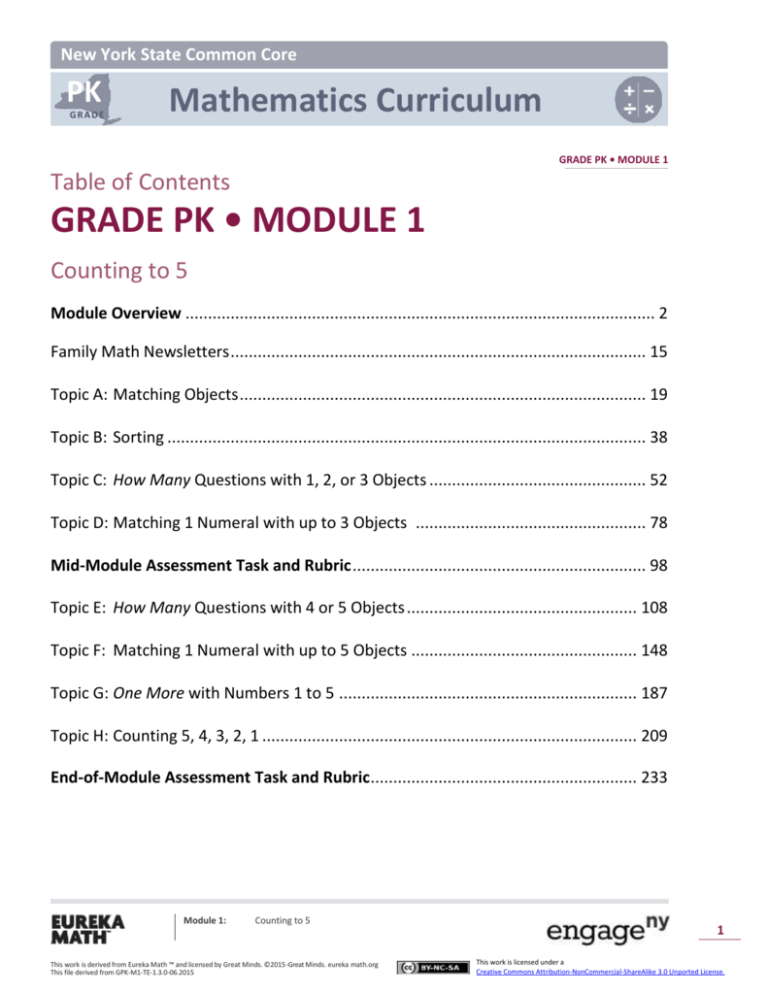
New York State Common Core PK GRADE Mathematics Curriculum GRADE PK • MODULE 1 Table of Contents GRADE PK • MODULE 1 Counting to 5 Module Overview ........................................................................................................ 2 Family Math Newsletters ............................................................................................ 15 Topic A: Matching Objects .......................................................................................... 19 Topic B: Sorting .......................................................................................................... 38 Topic C: How Many Questions with 1, 2, or 3 Objects ................................................ 52 Topic D: Matching 1 Numeral with up to 3 Objects ................................................... 78 Mid-Module Assessment Task and Rubric ................................................................. 98 Topic E: How Many Questions with 4 or 5 Objects ................................................... 108 Topic F: Matching 1 Numeral with up to 5 Objects .................................................. 148 Topic G: One More with Numbers 1 to 5 .................................................................. 187 Topic H: Counting 5, 4, 3, 2, 1 ................................................................................... 209 End-of-Module Assessment Task and Rubric ........................................................... 233 Module 1: Counting to 5 This work is derived from Eureka Math ™ and licensed by Great Minds. ©2015 -Great Minds. eureka math.org This file derived from GPK-M1-TE-1.3.0-06.2015 1 This work is licensed under a Creative Commons Attribution-NonCommercial-ShareAlike 3.0 Unported License. Module Overview NYS COMMON CORE MATHEMATICS CURRICULUM Grade PK • Module 1 Counting to 5 OVERVIEW Module 1 capitalizes on the energy and excitement young students have as they enter their first day of Pre-K by providing a playful and active, yet carefully sequenced structure through which children progress. In this module, we set up a friendly learning environment in which children have sustained interaction with four core ideas, collectively referred to as the number core (PK.CC.1–4): Rote counting (the number word list, i.e., one, two, three…) One-to-one correspondence (one object paired with one number word) Cardinality (how many in a set) Written numerals Throughout the module, children have experiences that help them make critical connections between these four understandings. In Topics A and B, students begin exploring the number word list and one-to-one correspondence with quantities to 3. However, their primary learning in these topics is a series of matching and sorting activities that allows them to focus on the attributes of objects (MP.6) and articulate their observations (MP.3). In Topic A, children match concrete objects in multiple ways using specific vocabulary, e.g., exactly the same, the same, but…, to describe their thoughts. In Topic B, children sort objects into groups using given attributes such as color, shape, size, and texture (PK.MD.2). This topic lays the foundation for understanding, forming, and counting sets of objects, which leads to the how many questions introduced in Topic C. Topics C and D support children in making connections between the four aspects of the number core. Topics A and B ask students to say the number names in standard order when counting, pairing each object with one and only one number name (PK.CC.3a). Topic C’s how many questions require students to incorporate cardinality, understanding that the last number name said tells the number of objects counted (PK.CC.3b). Children begin to generalize this knowledge as they use one-to-one correspondence to count a set of 3 objects in scattered and linear configurations (PK.CC.4). In Topic D, children begin to match quantities of 1 to 3 objects to a numeral (PK.CC.2). They work with prewritten numerals as they build the fine motor skills necessary to start writing numerals in later modules. Children also practice counting out a specified number of objects (up to 3) by matching them to an existing set. Initially, they do this by counting a group of craft sticks to match a group of dots. This practice prepares them to count out a group of objects by hearing or seeing the numeral (PK.CC.4). The MidModule Assessment is given after Topic D, during which each child is interviewed and observed to determine how well she understands sorting, making groups, and counting to 3. Module 1: Counting to This work is derived from Eureka Math ™ and licensed by Great Minds. ©2015 -Great Minds. eureka math.org This file derived from GPK-M1-TE-1.3.0-06.2015 2 This work is licensed under a Creative Commons Attribution-NonCommercial-ShareAlike 3.0 Unported License. NYS COMMON CORE MATHEMATICS CURRICULUM Module Overview Topics E and F mimic Topics C and D, extending children’s understanding of the number core to quantities of 4 and 5. They practice strategies for counting array, circular, and scattered configurations, tracking their counting paths to ensure one-to-one correspondence (PK.CC.4). They also learn to count the Math Way, starting with the left pinky finger and moving toward the thumb, using a piano template (shown on right). Playing the piano in this way prepares them to count 6, 7, 8, 9, 10, beginning with the right thumb and continuing to the right pinky. Also, in counting the Math Way on the piano, students see the number of fingers increase as they count from 1 to 5, moving from left pinky to thumb without interruption. This provides a foundation for understanding the number path and number line, on which numbers also increase from left to right. Internalization of the number line develops multiple areas of number sense and facilitates future work with operations. Throughout Topics E and F, children have opportunities to find smaller numbers embedded within larger numbers (e.g., 1 and 3 are inside 4). This precursor to composition and decomposition of numbers prepares students to work with addition and subtraction later in the year. In Topic G, students use their skill with rote counting and their subsequent knowledge of number names to find the pattern of 1 more as they build number stairs for quantities 1–5, recognizing that each successive number name refers to a quantity that is one larger (PK.CC.4d). They learn to look at the numbers 1–4 and to answer “What is 1 more?” and “What comes after?” (PK.CC.1–4, PK.OA.2). This also enables students to connect counting sequences to quantities and to understand the 1 more pattern using concrete objects. In Topic H, children break down a tower of 5, removing one cube at a time while counting backwards (PK.OA.2). Topics G and H help students build an understanding of the relationships between numbers and the pattern embedded in the counting sequence. These important insights will serve as the basis for counting on in Grade 1. Module 1: Counting to This work is derived from Eureka Math ™ and licensed by Great Minds. ©2015 -Great Minds. eureka math.org This file derived from GPK-M1-TE-1.3.0-06.2015 3 This work is licensed under a Creative Commons Attribution-NonCommercial-ShareAlike 3.0 Unported License. NYS COMMON CORE MATHEMATICS CURRICULUM Module Overview Focus Grade Level Standards Know number names and the count sequence. PK.CC.1 Count to 20. PK.CC.2 Represent a number of objects with a written numeral 0–5 (with 0 representing a count of no objects). Module 1: Counting to This work is derived from Eureka Math ™ and licensed by Great Minds. ©2015 -Great Minds. eureka math.org This file derived from GPK-M1-TE-1.3.0-06.2015 4 This work is licensed under a Creative Commons Attribution-NonCommercial-ShareAlike 3.0 Unported License. Module Overview NYS COMMON CORE MATHEMATICS CURRICULUM Count to tell the number of objects.1 PK.CC.3 Understand the relationship between numbers and quantities to 10; connect counting to cardinality. a. When counting objects, say the number names in the standard order, pairing each object with one and only one number name and each number name with one and only one object. b. Understand that the last number name said tells the number of objects counted. The number of objects is the same regardless of their arrangement or the order in which they were counted. c. Understand that each successive number name refers to a quantity that is one larger. PK.CC.4 Count to answer "how many?" questions about as many as 10 things arranged in a line, a rectangular array, or a circle, or as many as 5 things in a scattered configuration; given a number from 1–10, count out that many objects. Understand simple patterns. PK.OA.2 Duplicate and extend (e.g., what comes next?) simple patterns using concrete objects. Sort objects and count the number of objects in each category. PK.MD.2 Sort objects into categories; count the number of objects in each category (limit category counts to be less than or equal to 10). Focus Standards for Mathematical Practice MP.3 Construct viable arguments and critique the reasoning of others. Students begin to describe their choices for matching and sorting. They can briefly articulate the reasons why objects match or belong in a particular group. MP.5 Use appropriate tools strategically. Students use objects to model situations and then count to tell how many. MP.6 Attend to precision. Students hone their observation skills by attending to and describing the specific characteristics shared by members of a group. Through repeated practice, they become more precise in describing the cardinality of a group and counting out a specific number of things. MP.7 Look for and make use of structure. Students notice that as they build number stairs for numbers 1–5, there is 1 more cube in each successive number. They also notice the pattern of 1 less as they count backward from 5, removing one cube at a time. 1Within 5. Module 1: Counting to This work is derived from Eureka Math ™ and licensed by Great Minds. ©2015 -Great Minds. eureka math.org This file derived from GPK-M1-TE-1.3.0-06.2015 5 This work is licensed under a Creative Commons Attribution-NonCommercial-ShareAlike 3.0 Unported License. Module Overview NYS COMMON CORE MATHEMATICS CURRICULUM Overview of Module Topics and Lesson Objectives Standards Topics and Objectives PK.MD.2 PK.CC.1 PK.MD.2 PK.CC.1 PK.CC.1 PK.CC.3ab PK.CC.4 PK.MD.2 A B C Matching Objects Lesson 1: Match 2 objects that are exactly the same. Lessons 2–3: Match 2 objects that are the same, but…. Lesson 4: Match 2 objects that are used together. Sorting Lesson 5: PK.CC.1 PK.CC.3ab PK.CC.4 PK.MD.2 4 3 Make one group with a given attribute. Lesson 6: Sort into two groups. Lesson 7: Sort the same group of objects in two different ways. 4 How Many Questions with 1, 2, or 3 Objects Lesson 8: Count up to 3 objects. Lessons 9–10: Arrange and count up to 3 objects in scattered and linear configurations. Lesson 11: PK.CC.2 PK.CC.3ab PK.CC.4 PK.CC.1 Days D E Arrange and count up to 3 objects to play a game. Matching 1 Numeral with up to 3 Objects Lesson 12: Match the numerals 1, 2, and 3 to quantities. Lesson 13: Make a group of up to 3 objects and match the numeral (concrete to abstract). Lesson 14: Look at a numeral and count out a group of objects to match (abstract to concrete). 3 Mid-Module Assessment: Topics A–D (interview style assessment, 4 days) 4 How Many Questions with 4 or 5 Objects Lessons 15–16: Arrange and count up to 5 objects in scattered and linear configurations. 6 Lesson 17: Count fingers on the left hand from 1 to 5. Lesson 18: Arrange and count 4 objects in an array configuration. Lesson 19: Find embedded numbers within 4 and 5 objects. Lesson 20: Arrange and count 5 objects in a circular configuration. Module 1: Counting to This work is derived from Eureka Math ™ and licensed by Great Minds. ©2015 -Great Minds. eureka math.org This file derived from GPK-M1-TE-1.3.0-06.2015 6 This work is licensed under a Creative Commons Attribution-NonCommercial-ShareAlike 3.0 Unported License. Module Overview NYS COMMON CORE MATHEMATICS CURRICULUM Standards Topics and Objectives PK.CC.2 PK.CC.3ab PK.CC.4 F Days Matching 1 Numeral with up to 5 Objects Lesson 21: Count up to 4 objects and match the numerals. Lesson 22: Count up to 5 objects and match the numerals. Lesson 23: Make a group of up to 5 objects and match the numeral (concrete to abstract). Lesson 24: Look at a numeral and count out a group of objects to match (abstract to concrete). 7 Lessons 25–26: Represent numbers 1–5 using objects, pictures, and numerals. Lesson 27: PK.CC.3c PK.OA.2 PK.CC.2 PK.CC.5 PK.CC.3c PK.OA.2 PK.CC.2 PK.CC.5 G H Play a game involving numbers to 5. One More with Numbers 1 to 5 Lesson 28: Count 1, 2, 3, 4, 5 with stories. 5 Lesson 29: Find 1 more. Lesson 30: Build a tower by putting 1 more cube or block at a time. Lesson 31: Build number stairs showing 1 more with cubes. Lesson 32: Count up—What comes after? Counting 5, 4, 3, 2, 1 5 Lessons 33–34: Build descending number stairs at the concrete and pictorial levels. Lessons 35–36: Count 5, 4, 3, 2, 1 using a story and the fingers of the left hand. Lesson 37: Culminating task—sort objects by use and count each group; represent one group with a number tower and numeral. End-of-Module Assessment: Topics E–H (interview style assessment, 4 days) Total Number of Instructional Days Module 1: 4 45 Counting to This work is derived from Eureka Math ™ and licensed by Great Minds. ©2015 -Great Minds. eureka math.org This file derived from GPK-M1-TE-1.3.0-06.2015 7 This work is licensed under a Creative Commons Attribution-NonCommercial-ShareAlike 3.0 Unported License. NYS COMMON CORE MATHEMATICS CURRICULUM Module Overview Fluency New Fluency Topics Appearing in Module 1 Instruction Count 1–5 in different formations Count one-to-one within 5 Make a group of 1 to 5 objects Rote count to 5 Within 5, find 1 more or 1 less Terminology New or Recently Introduced Terms 1 less (e.g., 1 less than 4 is 3) 1 more (e.g., 1 more than 4 is 5) After (position word) Count (with reference to use of number core) Counting the Math Way (count fingers from left pinky to right pinky) Different (characteristic used to analyze objects to match or sort) Exactly the same (characteristic used to analyze objects to match or sort) Group (objects sharing one or more attributes) How many (with reference to counting quantities or sets) Line (with reference to counting configuration) Mark (with reference to starting point for count) Match (group items that are the same or that have the same given attribute) Number (numeral) One, two, three, four, five, six, seven (number words) Partners (embedded numbers) Size (generalized measurement term) Sort (group objects according to a particular attribute) The same, but… (characteristic used to analyze objects to match or sort) Module 1: Counting to This work is derived from Eureka Math ™ and licensed by Great Minds. ©2015 -Great Minds. eureka math.org This file derived from GPK-M1-TE-1.3.0-06.2015 8 This work is licensed under a Creative Commons Attribution-NonCommercial-ShareAlike 3.0 Unported License. Module Overview NYS COMMON CORE MATHEMATICS CURRICULUM Suggested Tools and Representations 5-group strips Concrete materials (e.g., linking cubes, blocks, bear counters, plastic animals, pennies, etc.) Dot cards, 1–5 Parking Lot Template Large dice with dots, 1–5 5-group Strip Matching mat Piano Mat Number stairs Number tower Numeral cards, 1–5 Parking lot template Number Stairs Piano mat Sets of numerals to 5 (cardboard, foam, etc.) Matching Mat Sorting mat Number Tower Sorting Mat Suggested Methods of Instructional Delivery Aligning A Story of Units Math Modules with ELA Domains The sequence of learning in A Story of Units is carefully constructed to develop deep understanding of the key foundational math content for each grade, as described by the Common Core State Standards. Research in early mathematics learning suggests teaching and learning paths appropriate for early childhood programs.2 The Pre-K math modules are sequenced based on this research. Where appropriate, math instruction incorporates aspects of the domains of the Pre-K Core Knowledge Language Arts. However, the primary driver of the curriculum is the sequence of math learning that will prepare children for success in subsequent grades. Language Facilitation in Math Language development occurs throughout the Pre-K day, and math time is no exception. The Pre-K math modules utilize the language stimulation and support techniques described in “Core Knowledge Language Arts Pre-K General Overview” to support consistency in language development. Comments: Effective use of teacher comments can stimulate discussion. “You have three yummy green grapes.” “You drew your tally marks next to each other.” Self-Talk: Teachers tell students what they are doing, observing, or thinking to model the types of language and vocabulary needed for specific math situations. “I need to count these bears. I’m going to put them in a line so they are easier to count: 1, 2, 3, 4, 5.” 2 The National Research Council’s Mathematics Learning in Early Childhood: Paths Toward Excellence and Equity describes teaching– learning paths appropriate for children from age two through Grade 1. Module 1: Counting to This work is derived from Eureka Math ™ and licensed by Great Minds. ©2015 -Great Minds. eureka math.org This file derived from GPK-M1-TE-1.3.0-06.2015 9 This work is licensed under a Creative Commons Attribution-NonCommercial-ShareAlike 3.0 Unported License. NYS COMMON CORE MATHEMATICS CURRICULUM Module Overview Labels and Object Descriptions: Children need support naming and describing objects and actions used in math instruction. “This group has large bears. That group has small bears.” Open Questions: With appropriate scaffolding, open questions give children an opportunity to express their own thoughts about math. Responses comprised of complete sentences are welcome, but not demanded. “Can objects be sorted in more than one way?” “Yes!” “Yes! We sorted by color and by size.” Parallel Talk: Describe what children are saying or doing to model language and vocabulary appropriate to the situation. “Ethan is making a group of things to take to school. He is sorting by use.” Expansion: By expanding a child’s idea into a sentence or phrase, teachers help children build the capacity to express complete ideas. Child: “3.” Teacher: “You have 3 bears?” Repetition: Teachers use repetition to help children understand the rules of language (articulation, pronunciation, vocabulary, syntax, and grammar). Child: “The twiangle has three pointy parts.” Teacher: “Yes, the triangle has three corners.” Modeling: In A Story of Units, teachers ask children to repeat key questions and phrases or provide sentence stems to help children express mathematical ideas. Guide Partner B to ask, “How many _______ (cows, pigs, etc.) did you count?” Partner A responds, “I counted 4 _______ (cows, pigs, etc.).” Scaffolds3 The scaffolds integrated into A Story of Units give alternatives for how students access information as well as express and demonstrate their learning. Strategically placed margin notes are provided within each lesson elaborating on the use of specific scaffolds at applicable times. They address many needs presented by English language learners, students with disabilities, students performing above grade level, and students performing below grade level. Many of the suggestions are organized by Universal Design for Learning (UDL) principles and are applicable to more than one population. To read more about the approach to differentiated instruction in A Story of Units, please refer to “How to Implement A Story of Units.” 3 Students with disabilities may require Braille, large print, audio, or special digital files. Please visit the website www.p12.nysed.gov/specialed/aim for specific information on how to obtain student materials that satisfy the National Instructional Materials Accessibility Standard (NIMAS) format. Module 1: Counting to This work is derived from Eureka Math ™ and licensed by Great Minds. ©2015 -Great Minds. eureka math.org This file derived from GPK-M1-TE-1.3.0-06.2015 10 This work is licensed under a Creative Commons Attribution-NonCommercial-ShareAlike 3.0 Unported License. NYS COMMON CORE MATHEMATICS CURRICULUM Module Overview Preparing to Teach a Module Preparation of lessons will be more effective and efficient if there has been an adequate analysis of the module first. Each module in A Story of Units can be compared to a chapter in a book. How is the module moving the plot, the mathematics, forward? What new learning is taking place? How are the topics and objectives building on one another? The following is a suggested process for preparing to teach a module. Step 1: Get a preview of the plot. A: Read the Table of Contents. At a high level, what is the plot of the module? How does the story develop across the topics? B: Preview the Concept Development Part 2: Practice portions of the module’s lessons4 to see the trajectory of the module’s mathematics and the nature of the work students are expected to be able to do. Note: If you are studying a PDF file, enter “Part 2: Practice” into the search feature to navigate from one Practice to the next. Step 2: Dig into the details. A: Dig into a careful reading of the Module Overview. As you read the narrative, liberally reference the lessons and Topic Overviews one paragraph at a time (or at times one sentence at a time) to clarify the meaning of the text—the lessons demonstrate the strategies, show how to use the models, clarify vocabulary, and build understanding of concepts. Consider searching the video gallery on Eureka Math’s website to watch demonstrations of the use of models and other teaching techniques. B: Having thoroughly investigated the Module Overview, read through the chart entitled Overview of Module Topics and Lesson Objectives to further discern the plot of the module. How do the topics flow and tell a coherent story? How do the objectives move from simple to complex? Make notes on new complexities. Step 3: Summarize the story. Complete the Mid- and End-of-Module Assessments. Use the strategies and models presented in the module to explain the thinking involved. Again, liberally reference the work done in the lessons to see how students who are learning with the curriculum might respond. 4This same process can be used to preview the coherence or flow of any component of the curriculum, such as the Fluency Practice or Application Problems. Module 1: Counting to This work is derived from Eureka Math ™ and licensed by Great Minds. ©2015 -Great Minds. eureka math.org This file derived from GPK-M1-TE-1.3.0-06.2015 11 This work is licensed under a Creative Commons Attribution-NonCommercial-ShareAlike 3.0 Unported License. NYS COMMON CORE MATHEMATICS CURRICULUM Module Overview Preparing to Teach a Lesson A three-step process is suggested to prepare a lesson. It is understood that at times teachers may need to make adjustments (customizations) to lessons to fit the time constraints and unique needs of their students. The recommended planning process is outlined below. Note: The ladder of Step 2 is a metaphor for the teaching sequence. The sequence can be seen not only at the macro level in the role that this lesson plays in the overall story, but also at the lesson level, where each rung in the ladder represents the next objective in the teaching sequence. As A Story of Units moves into the elementary grades, the ladder is also evident between selected problems, where each rung in the ladder represents the next step in understanding or the next skill needed to reach the objective. To reach the objective, or the top of the ladder, all students must be able to access the first rung and each successive rung. In Pre-K, new complexities are generally evidenced between objectives as opposed to within the selected problems in each lesson, as is the case in later grades. Step 1: Discern the plot. A: Briefly review the module’s Table of Contents, recalling the overall story of the module and analyzing the role of this lesson in the module. B: Read the Topic Overview related to the lesson, and then review the Concept Development Part 2: Practice of each lesson in the topic. C: Review the assessment tasks for the topic, keeping in mind that assessments can be found midway through the module and at the end of the module. Step 2: Find the ladder. A: Gather the necessary materials, and do the actions of the Concept Development (Concept Introduction and Practice) for each objective (lesson) in the topic and adjacent topics as necessary (e.g., if preparing the first lesson of a topic, return to the last lesson of the prior topic in order to make sense of the rungs between the lessons). B: Analyze and write notes on the new complexities of each objective in the topic (e.g., smaller to larger numbers, simple to challenging configurations, concrete to pictorial to abstract). The new complexities are the rungs of the ladder. C: Anticipate where students might struggle, and write a note about the potential cause of the struggle. D: Answer the Student Debrief questions, always anticipating how students will respond. Module 1: Counting to This work is derived from Eureka Math ™ and licensed by Great Minds. ©2015 -Great Minds. eureka math.org This file derived from GPK-M1-TE-1.3.0-06.2015 12 This work is licensed under a Creative Commons Attribution-NonCommercial-ShareAlike 3.0 Unported License. NYS COMMON CORE MATHEMATICS CURRICULUM Module Overview Step 3: Hone the lesson. At times, the lesson and the accompanying materials are appropriate for all students and the day’s schedule. At others, they may need customizing. If the decision is to customize based on either the needs of students or scheduling constraints, a suggestion is to create sets of materials that allow students to move through the concept from simple to complex. A: Having anticipated where students might struggle or need an extra challenge, identify appropriate customizations as detailed in the chart below. Anticipated Difficulty Customization Suggestion The task of the Practice is too challenging. Depending on the Practice task, consider using smaller quantities, different colors, or templates to support students working independently on the task. Once students feel confident in the task, remove the scaffolds. For example, if the task is to count 9 cubes, use 3 red, 3 yellow, and 3 blue cubes instead of mixed colors or all one color. There is too big of a jump in complexity between two lessons. Provide workstations for students to visit that repeat skills and objectives students have previously learned. For example, if students have trouble counting with one-to-one correspondence with numbers above 5, provide the supportive structure of a cropped egg carton with 10 slots to bridge to the task. Students lack fluency or foundational skills necessary for the lesson. Before beginning independent work on a Practice task, do a quick, engaging fluency exercise. Before beginning any fluency activity for the first time, assess that the sequence of questions begins by developing the concept at the simplest level before advancing. More work is needed at the concrete or pictorial level. Create sets of materials that allow students more practice with manipulatives or pictures before moving to a more complex skill. For example, continue to work with counters in a circle before asking students to count images printed in a circular configuration. More work is needed moving from abstract to concrete or abstract to pictorial. Hone the Practice to reduce the amount of drawing or use of manipulatives as appropriate for certain students or the whole class. For example, students who have already mastered counting a group and matching a numeral can be given a numeral and asked to create a matching group. B: Adjust the Practice to reflect the customizations or to address scheduling constraints. Create sets of extension materials for students who work with greater fluency and understanding and who, therefore, can complete more work within a given time frame. C: Consider how to best use the vignettes of the Concept Development section of the lesson. Read through the vignettes, and highlight selected parts to be included in the delivery of instruction so that students can be independently successful in their Practice. D: Pay close attention to the questions chosen for the Student Debrief. Regularly ask students, “What math are we learning today?” “Could you teach what you learned to someone else?” Help them articulate the goal to encourage metacognition and use of vocabulary. Module 1: Counting to This work is derived from Eureka Math ™ and licensed by Great Minds. ©2015 -Great Minds. eureka math.org This file derived from GPK-M1-TE-1.3.0-06.2015 13 This work is licensed under a Creative Commons Attribution-NonCommercial-ShareAlike 3.0 Unported License. NYS COMMON CORE MATHEMATICS CURRICULUM Module Overview Assessment Summary Assessment Type Administered Format Standards Addressed Mid-Module Assessment Task After Topic D Interview with rubric PK.CC.1 PK.CC.2 PK.CC.3ab PK.CC.4 PK.MD.2 *Numbers 1–3 End-of-Module Assessment Task After Topic H Interview with rubric PK.CC.1 PK.CC.2 PK.CC.3abc PK.CC.4 PK.OA.2 *Numbers 1–5 Culminating Task Lesson 37 Module 1: Sort objects by use and count each group; represent one group with a number tower and numeral. PK.CC.2 PK.CC.3abc PK.CC.4 PK.MD.2 Counting to This work is derived from Eureka Math ™ and licensed by Great Minds. ©2015 -Great Minds. eureka math.org This file derived from GPK-M1-TE-1.3.0-06.2015 14 This work is licensed under a Creative Commons Attribution-NonCommercial-ShareAlike 3.0 Unported License.

